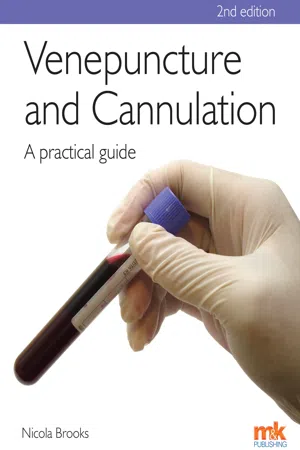
- English
- ePUB (mobile friendly)
- Available on iOS & Android
About this book
Venepuncture and Cannulation – A Practical Guide offers an easy-to-read, comprehensive account of the practical procedures of venepuncture and intravenous cannulation. It provides the underlying theory and underpinning knowledge required, as well as a step-by-step approach that will enable healthcare practitioners to carry out these procedures safely, efficiently and with confidence.This book is intended as a supplementary resource for those involved in practising or teaching these procedures, for healthcare practitioners wishing to update their knowledge, and for novice practitioners learning these skills for the first time. Each chapter contains intended learning outcomes and points for practice. Some chapters also include helpful illustrations and practical activities, and the book ends with two self-assessment checklists.This second edition has been thoroughly updated and includes a very useful 'Test yourself' chapter at the end of the book. Readers can now test their knowledge by answering the relevant questions. They can also identify any gaps in their current level of knowledge or skill, as well as further learning opportunities that may be required to support their practice.
Frequently asked questions
- Essential is ideal for learners and professionals who enjoy exploring a wide range of subjects. Access the Essential Library with 800,000+ trusted titles and best-sellers across business, personal growth, and the humanities. Includes unlimited reading time and Standard Read Aloud voice.
- Complete: Perfect for advanced learners and researchers needing full, unrestricted access. Unlock 1.4M+ books across hundreds of subjects, including academic and specialized titles. The Complete Plan also includes advanced features like Premium Read Aloud and Research Assistant.
Please note we cannot support devices running on iOS 13 and Android 7 or earlier. Learn more about using the app.
Information














Table of contents
- Cover Page
- Title Page
- Copyright
- Contents
- Preface
- About the author
- Acknowledgements
- 1. What are venepuncture and cannulation?
- 2. An overview of the circulatory system and the related anatomy and physiology of the peripheral vascular system
- 3. Vein selection
- 4. Preparing yourself, your environment and your patient
- 5. Venepuncture techniques
- 6. Venepuncture – when things go wrong
- 7. Cannulation
- 8. Cannulation technique
- 9. Cannulation – when things go wrong
- 10. Reducing risks when carrying out venepuncture and cannulation
- 11. Test your knowledge
- Appendix 1: Self-assessment checklist for venepuncture to ensure safe practice
- Appendix 2: Self-assessment checklist for cannulation to ensure safe practice
- Answers to Chapter 11 test questions
- References
- Further reading
- Index